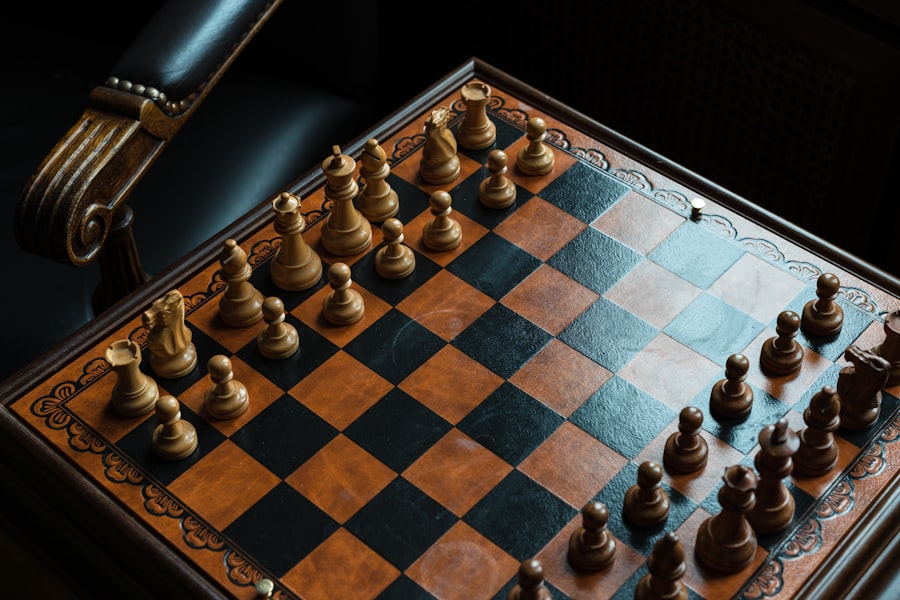Download links
How to install Mastering the Art of Chess Strategy APK?
1. Tap the downloaded Mastering the Art of Chess Strategy APK file.
2. Touch install.
3. Follow the steps on the screen.
Description
When we delve into the world of chess, we quickly realize that strategy forms the backbone of this intricate game. At its core, chess strategy involves the long-term planning and positioning of our pieces to create advantageous situations. Unlike tactics, which often focus on immediate gains, strategy requires us to think several moves ahead, considering not only our own plans but also the potential responses of our opponent.
This duality of thought is what makes chess both challenging and rewarding. We must learn to evaluate the strengths and weaknesses of our position while also anticipating our opponent’s intentions. To build a solid foundation in chess strategy, we should familiarize ourselves with key concepts such as control of the center, piece development, and king safety.
Controlling the center of the board allows us to exert influence over the game, providing our pieces with greater mobility and options for attack. Developing our pieces efficiently ensures that we are not only prepared for the middle game but also sets us up for a strong endgame. Additionally, safeguarding our king is paramount; a well-protected king can withstand attacks and provide us with the stability needed to execute our plans.
By understanding these fundamental principles, we can begin to formulate our own strategic approach to the game.
Key Takeaways
- Understanding the basics of chess strategy is crucial for developing a strong foundation in the game.
- Developing a strong opening repertoire is essential for gaining an early advantage and controlling the game.
- Mastering tactical and positional play is key to creating threats and maintaining a strong position on the board.
- Utilizing endgame techniques is important for converting advantages into a winning position.
- Developing a deep understanding of pawn structure is crucial for controlling the center and creating long-term advantages on the board.
- Applying strategic thinking in real game situations is essential for making sound decisions and capitalizing on opportunities during a game.
Developing a Strong Opening Repertoire
Understanding Our Playing Style
We should aim to familiarize ourselves with a variety of openings that suit our playing style, whether we prefer aggressive tactics or a more solid, defensive approach. By doing so, we can adapt to different opponents and situations, making us more versatile players.
Delving Deeper into Opening Principles
In building our repertoire, it is essential to understand not just the moves but also the underlying ideas behind each opening. For instance, if we choose to play the Sicilian Defense, we should grasp its principles, such as counterattacking and asymmetrical pawn structures. This knowledge enables us to navigate the complexities of the opening phase more effectively and respond appropriately to our opponent’s strategies.
Practice and Review for Success
Additionally, we should regularly review and practice our chosen openings through games and analysis, ensuring that we remain sharp and ready for any challenges that may arise.
Mastering Tactical and Positional Play

As we deepen our understanding of chess, we encounter two fundamental aspects: tactical and positional play. Mastering these elements is crucial for elevating our game to higher levels. Tactics involve short-term calculations and combinations that can lead to immediate advantages, such as winning material or delivering checkmate.
We must train ourselves to recognize tactical motifs like forks, pins, and discovered attacks, as these can turn the tide of a game in an instant. Regular practice through puzzles and tactical exercises can significantly enhance our ability to spot these opportunities during actual games. On the other hand, positional play focuses on long-term advantages and strategic maneuvering.
It requires us to evaluate piece placement, pawn structure, and control of key squares. While tactics may win battles, it is often positional understanding that wins wars in chess. We should strive to develop a keen sense of when to exchange pieces, how to create weaknesses in our opponent’s position, and when to consolidate our own advantages.
Balancing tactical awareness with positional understanding will make us formidable opponents on the chessboard.
Utilizing Endgame Techniques
| Technique | Definition | Example |
|---|---|---|
| Opposition | Placing the king directly in front of the opponent’s king to restrict its movement | King on e4 and e6, with white to move |
| Zugzwang | Forcing the opponent to make a disadvantageous move | Black is in zugzwang and must make a move that worsens their position |
| Triangulation | Wasting a move to put the opponent in a worse position | King moves in a triangular pattern to lose a tempo |
The endgame is often regarded as one of the most critical phases of chess, yet it is frequently overlooked by many players. As we transition from the middle game to the endgame, it becomes essential for us to apply specific techniques that can lead us to victory or salvage a draw from a seemingly lost position. Understanding fundamental endgame principles—such as king activity, pawn promotion, and piece coordination—can significantly impact our results in this phase of the game.
One key aspect of endgame play is recognizing winning techniques in various scenarios. For instance, knowing how to convert a material advantage into a win or how to hold a draw with limited resources can be invaluable. We should study classic endgames, such as king and pawn versus king or rook versus pawn scenarios, to internalize these concepts.
By practicing these techniques regularly, we can build confidence in our endgame skills and ensure that we are well-prepared for any situation that arises as the game progresses.
Developing a Deep Understanding of Pawn Structure
Pawn structure is often considered one of the most critical elements in chess strategy. As we navigate through games, we must pay close attention to how pawns interact with one another and how they influence piece mobility and control over key squares. A solid understanding of pawn structure allows us to identify strengths and weaknesses in both our position and that of our opponent.
By analyzing pawn formations—such as isolated pawns, doubled pawns, or pawn chains—we can make informed decisions about how to proceed in the game. Moreover, pawn structure often dictates the nature of the middlegame and endgame strategies we should adopt. For example, if we find ourselves with an isolated pawn, we may need to adopt a more aggressive stance to compensate for its weaknesses.
Conversely, if we have a strong pawn chain, we can focus on maintaining its integrity while preparing for an eventual breakthrough. By developing a keen awareness of pawn structure and its implications on our overall strategy, we can enhance our decision-making process and improve our chances of success on the board.
Applying Strategic Thinking in Real Game Situations

Finally, as we strive to become better chess players, it is crucial for us to apply strategic thinking in real game situations. This involves synthesizing all the knowledge we’ve acquired about openings, tactics, positional play, endgames, and pawn structures into cohesive strategies during actual matches. We must learn to remain calm under pressure and make decisions based on careful analysis rather than impulsive reactions.
In practical terms, this means taking time during our games to evaluate each position thoroughly before making a move. We should ask ourselves questions about piece activity, potential threats from our opponent, and how our plans align with the overall strategic goals we’ve set for ourselves. By cultivating this habit of strategic thinking during games, we can improve not only our performance but also our enjoyment of chess as a whole.
If you’re a fan of strategy games like chess, you may also enjoy learning English for free with the Cake app. This article discusses how Cake can help you improve your language skills while having fun. Just like chess, mastering a new language requires strategic thinking and practice. Check out the article to see how Cake can help you level up your English skills.
FAQs
What is chess?
Chess is a two-player strategy board game that is played on an 8×8 grid. It is one of the most popular and enduring games in the world, with a rich history dating back over 1500 years.
How is chess played?
Chess is played on a square board divided into 64 squares of alternating colors. Each player starts with 16 pieces: one king, one queen, two rooks, two knights, two bishops, and eight pawns. The objective of the game is to checkmate the opponent’s king, which means putting the king into a position where it cannot escape capture.
What are the basic rules of chess?
Each type of chess piece moves in a specific way: the king moves one square in any direction, the queen moves any number of squares in any direction, the rook moves any number of squares horizontally or vertically, the bishop moves any number of squares diagonally, the knight moves in an L-shape, and the pawn moves forward one square and captures diagonally. The game ends when a player’s king is in checkmate, or when a stalemate is reached.
What are the benefits of playing chess?
Chess has been shown to have numerous cognitive benefits, including improving memory, concentration, problem-solving skills, and strategic thinking. It is also a great way to improve patience and decision-making abilities.
What is the history of chess?
Chess originated in India around the 6th century and spread to Persia, where it became known as “shatranj.” It then spread to the Arab world and Europe, evolving into the modern game of chess that we know today. Chess has a rich and storied history, with many famous players and memorable games.





